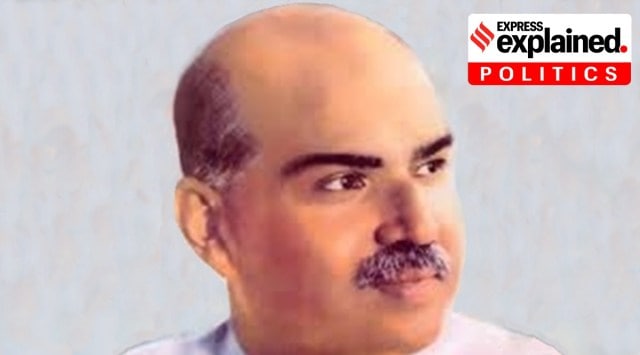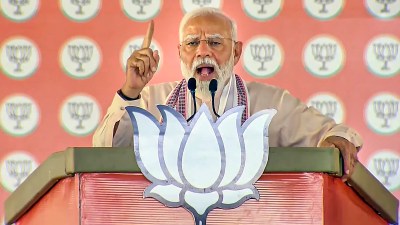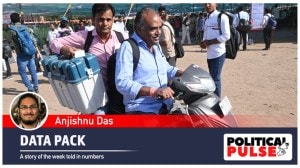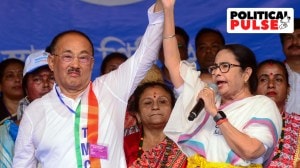- India
- International
Explained: Why Syama Prasad Mookerjee opposed the United Bengal plan
Historians of Bengal Partition agree that the Calcutta riots were by far the most cataclysmic event leading to the Partition of the region.
 For Mookerjee the idea of a united Bengal was not appealing because he believed that a ‘sovereign undivided Bengal would be a virtual Pakistan’. (File)
For Mookerjee the idea of a united Bengal was not appealing because he believed that a ‘sovereign undivided Bengal would be a virtual Pakistan’. (File)In a recent election rally in Muchipara, West Bengal, BJP leader Suvendu Adhikari spoke about the contributions of the party’s founding father, Syama Prasad Mookerjee. “Without Syama Prasad Mookerjee’s contribution, this country would have been an Islamic country and we would be living in Bangladesh,” he said about the founder of the Bharatiya Jana Sangh, the predecessor of the BJP.
Mookerjee, who was president of the Akhil Bharatiya Hindu Mahasabha between 1943 and 1946, was one of the strongest voices to have opposed the united Bengal plan of the Bengal provincial Muslim League leader and prime minister of Bengal Huseyn Shaheed Suhrawardy, as per which Bengal would be a separate nation, independent from both India and Pakistan.
How was the United Bengal plan conceived?
A most striking aspect of the Partition of Bengal was the fact that the same Bengali Hindus who had vociferously opposed the 1905 partition of the region by Lord Curzon, were the ones who demanded the division of the province on communal lines less than half a century later. One way to understand this is by noting the fact that the communal skirmishes that had started in 1905, reached its peak by 1947. But there was also the fact that Bengal politics changed dramatically in 1932 with the introduction of the Communal Award.
It gave more seats in the Legislative Council to Muslims than Hindus. It also provided separate electorates for the Dalits. Consequently, Bengali Hindus ceased to be as significant and visible in provincial politics as they were before. Political scientist Bidyut Chakrabarty in his book, ‘The Partition of Bengal and Assam,1932-1947: Contour of freedom’ writes that in the aftermath of the 1937 elections when the Krishak Praja Party (KPP) and the Muslim League formed a coalition government in Bengal, they took a number of legislative steps to ameliorate the condition of the Muslims in the state. “In a situation where Muslims constituted a majority but lived under the socio-economic condition of the Hindu majority, any attempt to improve the conditions of the former was bound to provoke opposition from the Hindus,” he writes. “Hindu politicians both within and outside the legislature characterised them as well-engineered devices to squash the Hindus.
What further aggravated the situation was the communal violence in Calcutta in August 1946 and those in Noakhali just seven weeks later. Historians of Bengal Partition agree that the Calcutta riots were by far the most cataclysmic event leading to the Partition of the region. Consequently, in February 1947, the Hindu Mahasabha under Mookerjee put forward the demand for dividing Bengal on religious grounds.

In the meantime, however, Suhrawardy along with few other top Bengal politicians like Sarat Bose and K.S. Roy came up with an alternative for the Partition. They argued for a united Bengal, independent from India and Pakistan. Suhrawardy had realised that the Partition of Bengal would mean economic disaster for East Bengal since all jute mills, coal mines and industrial plants would go to the western part of the state. “Suhrawardy argued strongly for a united Bengal because Bengal was indivisible in view of its ‘economic integrity, mutual reliance and the necessity of creating a strong workable state’”, writes Chakrabarty.
Further, Suhrawardy argued that Bengal remained economically backward because of the presence of a large number of non-Bengali businessmen who exploited the people of the region for their own benefit. Hence, if Bengal was to prosper economically, it had to stand independent and in charge of its own resources. There was also the factor that Calcutta, which was the largest city in India at that time and the commercial capital of the country, would go to the western part, were Partition to happen.
Why did Mookerjee oppose the united Bengal plan?
The Hindu Mahasabha under Mookerjee spearheaded a fierce attack against the united Bengal scheme, which he thought would force Hindus to live under Muslim domination. In a letter to Viceroy Mountbatten, as reproduced in Chakrabarty’s book, Mookerjee argued, “if ever an impartial survey is made of Bengal’s administration in the last ten years, it will appear that Hindus have suffered not only on account of communal riots and disturbance, but in every sphere of national activities, educational, economic, political and even religious.”
He further defended the Partition to the Viceroy by drawing upon Jinnah’s two nation theory. He argued that since according to Jinnah Hindus and Muslims are two separate nations and Muslims must have their own state, therefore Hindus in Bengal who constitute almost half of the region’s population may well demand that they must not be compelled to live under Muslim domination.
Finally, for Mookerjee the idea of a united Bengal was not appealing because he believed that a ‘sovereign undivided Bengal would be a virtual Pakistan’.
Eventually, the idea of a united Bengal failed to garner sufficient support from among the Muslim League and the Congress. It also did not find sufficient support from the grassroots as most Hindus favoured the Partition of Bengal.
More Explained
EXPRESS OPINION
Apr 25: Latest News
- 01
- 02
- 03
- 04
- 05










































